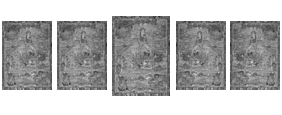
Item: Amitabha Buddha - Sambhogakaya
| Origin Location | Tibet |
|---|---|
| Date Range | 1300 - 1399 |
| Lineages | Buddhist |
| Size | 64.77x50.80cm (25.50x20in) |
| Material | Ground Mineral Pigment on Cotton |
| Collection | Rubin Museum of Art |
| Catalogue # | acc.# P1994.23.1 |
Classification: Deity
Appearance: Peaceful
Gender: Male
Amitabha, Buddha (English: the Enlightened One of Immeasurable Light) adorned with lavish sambhogakaya vestments, surrounded by 8 bodhisattvas, 210 buddhas and 4 wrathful deities.

Red in colour with one face and two hands, youthful in appearance, he sits in the posture of formal meditation. The eyes gaze forward slightly closed and a dark red dot on the forehead (Sanskrit: urna) sits between two long narrow eyebrows. Three horizontal lines adorn the neck - marks of beauty. The dark hair is piled on the top of the head with some falling loose across the shoulders and down the back. Further descending from the shoulders the arms curve gently downward forming a circle framing the narrow waist - another mark of beauty. The two hands meet in the lap and join with palms upward right over left to form the mudra (gesture) of meditation. Richly adorned with sambhogakaya vestments the head is decorated with a crown of gold and jewels topped with an upright golden half vajra. White ribbons hang from the sides and flowers adorn the tips of the ears. Large gold earrings studded with jewels hang from the distended lobes. The neck and youthful breast are covered with various necklaces and chokers. The arms, wrists and ankles display bracelets and bangles of various design. Wearing a lower garment of a thin skirt comprising variously coloured silks, he sits in full vajra posture with the legs folded, right foot over left, atop a moon disc and multi-coloured lotus blossom above a peacock supported tiered throne of gold and jewels. A blue nimbus and green aureola edged with yellow completely surround the body and head.
The backrest is composed of the 'six ornament' design. On each side, at the left and right, are elephants supporting a white snow lion, a small boy with an animal lower torso, blue horse, a makara (sea creature), naga - with a human upper torso and at the top a single garuda bird with unfurled wings - all stacked one above the other. Symbolically the 'six ornaments' have many meanings such as the 'six perfections' and the like.
At the left side is a standing Bodhisattva, red in colour, with the right hand held to the heart in the mudra of blessing and the left at the waist holding the stem of a flower blossom. Adorned with a crown, jewel ornaments and a multi-coloured lower garment he stands on a lotus seat. At the right side is a blue Bodhisattva holding a sword upraised in the right hand and performing the mudra of blessing with the left. Above these two figures, on both sides, are three seated bodhisattvas, red in colour, making a total of 8.
Located on the middle section of the throne is a small red Buddha figure, seated in meditation posture. Directly below are 4 wrathful figures, blue and red in colour, with various numbers of faces and arms. At each side of the throne is a standing red figure, female on the left and male in a dancing posture at the right. Surrounding all of that are 210 buddha figures, aligned in rows, each with one face and two hands performing the mudra of Dharma teaching at the heart, wearing red robes and seated in vajra posture, surrounded by circles of light.
Jeff Watt 8-99
Collection of Rubin Museum of Art: Painting Gallery 6
Buddhist Deity: Amitabha Buddha Main Page (阿弥陀佛 / འོད་དཔག་མེད།)
Buddhist Deity: Amitabha (Sarvadurgati Tantra)
Subject: Torana, Amitabha & Amitayus Buddha (Early Animal Depictions)
Buddhist Deity: Amitabha (Charya & Yoga Tantras)
